Leading & Managing HR Development: A Contemporary HRM Study of Tesco
VerifiedAdded on 2023/06/09
|24
|6936
|483
Report
AI Summary
This report provides a comprehensive analysis of Human Resource (HR) development and leadership styles within Tesco Plc., a British multinational retailer. It explores the impact of globalization on HR practices, examining how changes in the global environment affect Tesco's strategies and policies. The report delves into Tesco's leadership style, emphasizing its democratic approach and its impact on employee satisfaction and performance. Furthermore, it includes a PESTLE analysis to evaluate the external factors influencing Tesco's operations, such as political, economic, social, technological, environmental, and legal aspects. The study also covers strategic planning processes, stakeholder analysis, unionization, and the competitive environment within which Tesco operates. Additionally, the report discusses the role of HR in organizational dynamics, conflict management, ethical practices, and Corporate Social Responsibility (CSR) initiatives at Tesco. Finally, the report includes a personal development plan, reflecting on the author's professional growth and future objectives. This document is available on Desklib, which provides a platform for students to access similar solved assignments and study resources.
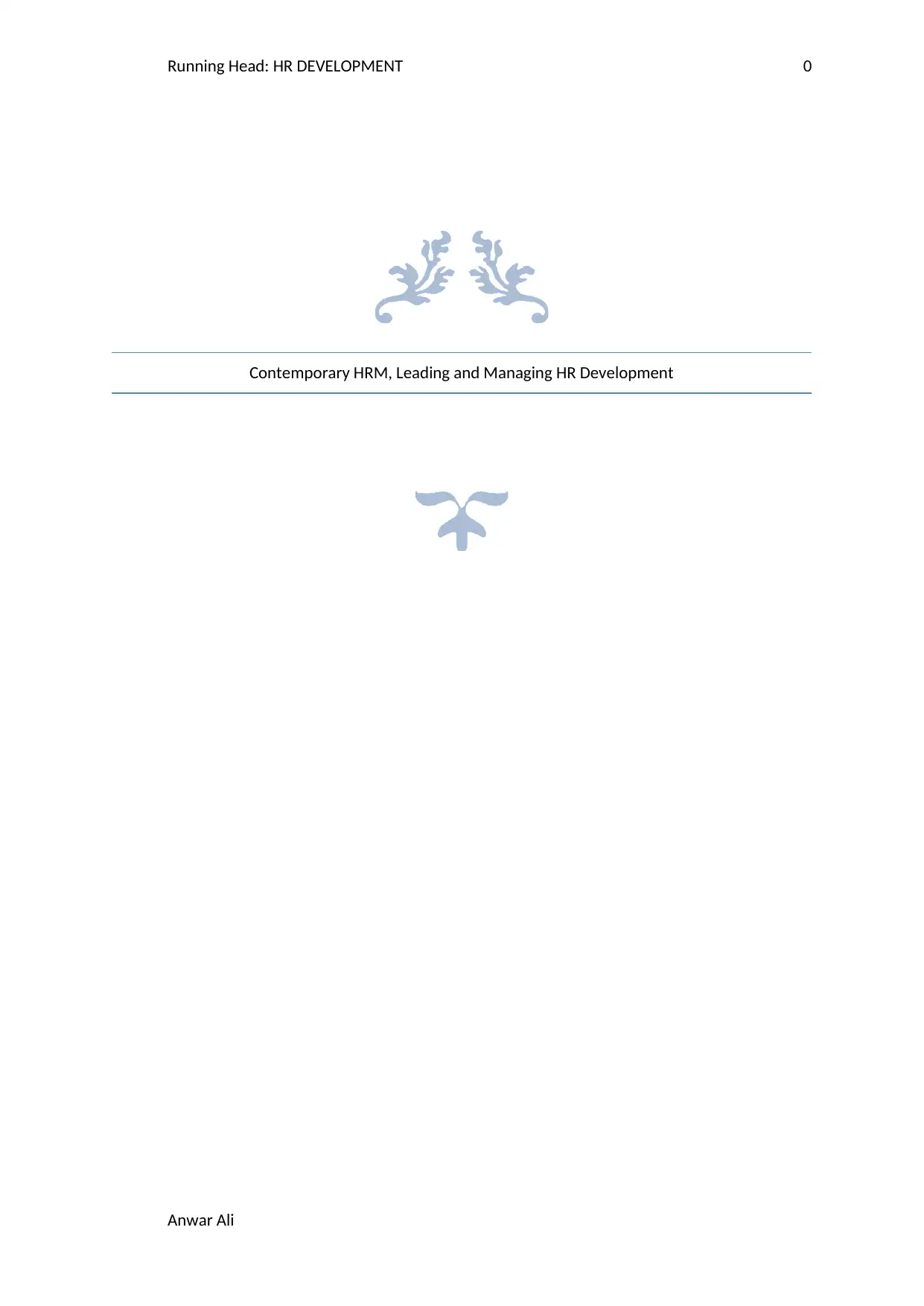
Running Head: HR DEVELOPMENT 0
Contemporary HRM, Leading and Managing HR Development
Anwar Ali
Contemporary HRM, Leading and Managing HR Development
Anwar Ali
Paraphrase This Document
Need a fresh take? Get an instant paraphrase of this document with our AI Paraphraser
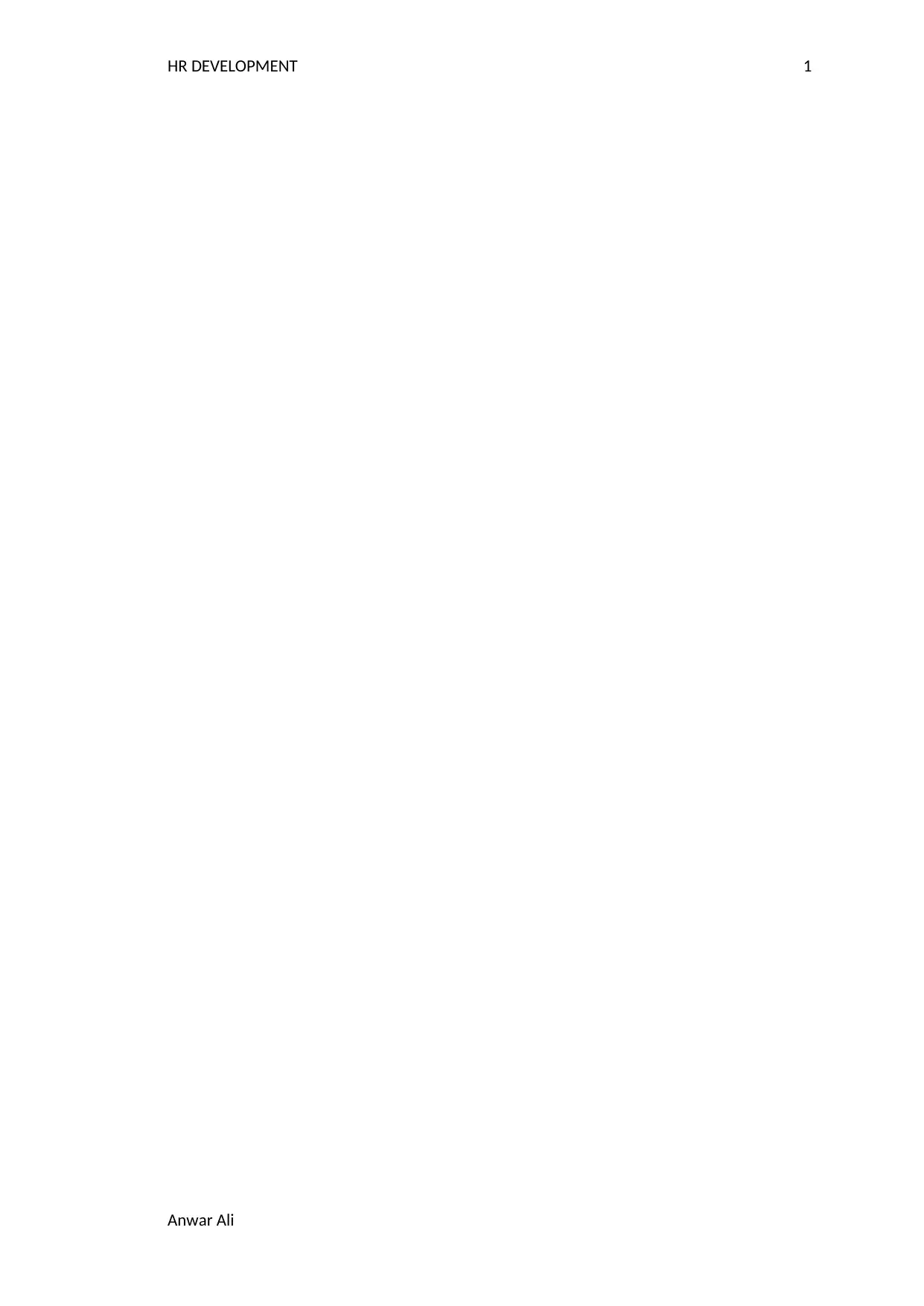
HR DEVELOPMENT 1
Anwar Ali
Anwar Ali
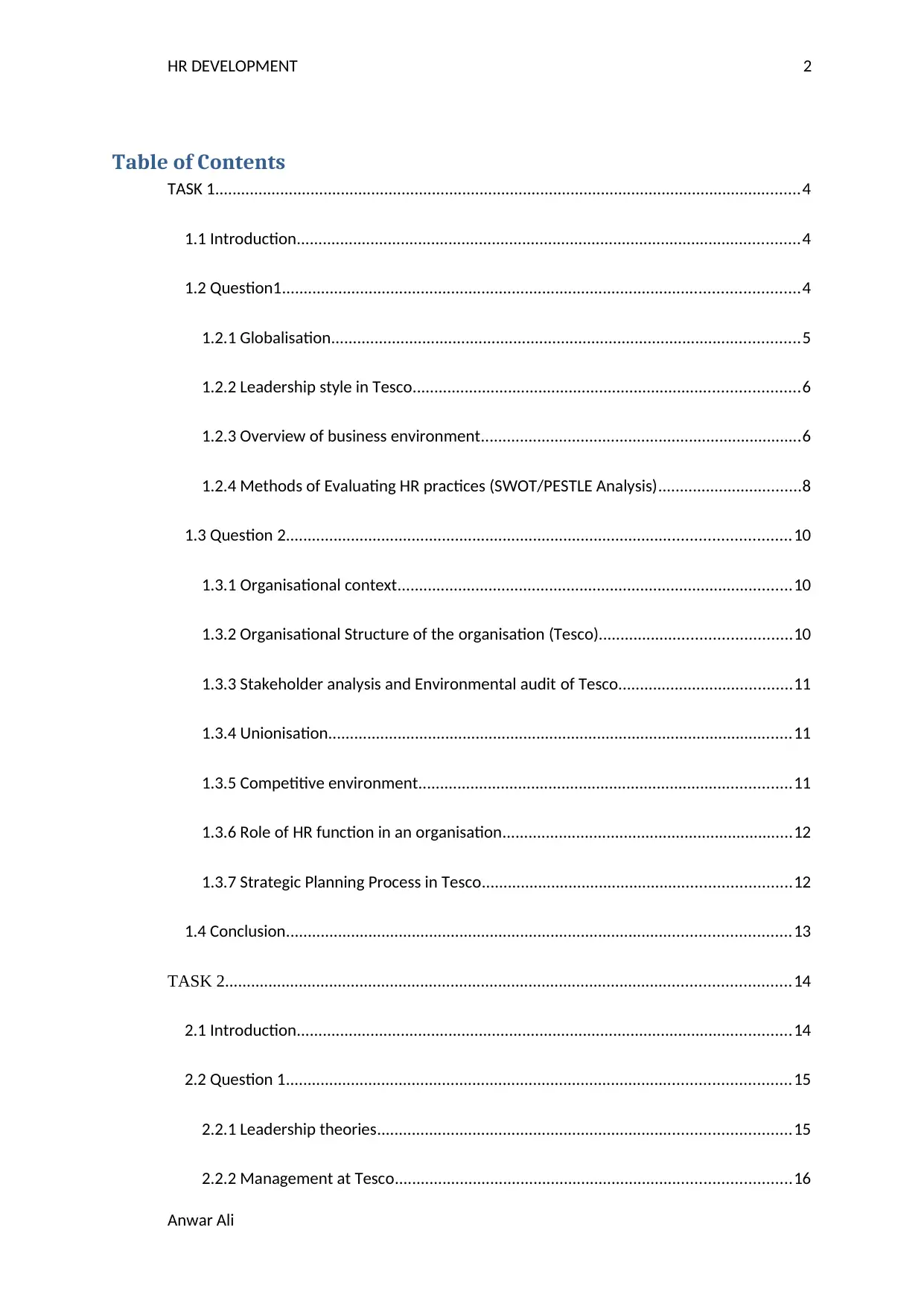
HR DEVELOPMENT 2
Table of Contents
TASK 1.......................................................................................................................................4
1.1 Introduction....................................................................................................................4
1.2 Question1.......................................................................................................................4
1.2.1 Globalisation............................................................................................................5
1.2.2 Leadership style in Tesco.........................................................................................6
1.2.3 Overview of business environment..........................................................................6
1.2.4 Methods of Evaluating HR practices (SWOT/PESTLE Analysis).................................8
1.3 Question 2....................................................................................................................10
1.3.1 Organisational context...........................................................................................10
1.3.2 Organisational Structure of the organisation (Tesco)............................................10
1.3.3 Stakeholder analysis and Environmental audit of Tesco........................................11
1.3.4 Unionisation...........................................................................................................11
1.3.5 Competitive environment......................................................................................11
1.3.6 Role of HR function in an organisation...................................................................12
1.3.7 Strategic Planning Process in Tesco.......................................................................12
1.4 Conclusion....................................................................................................................13
TASK 2..................................................................................................................................14
2.1 Introduction..................................................................................................................14
2.2 Question 1....................................................................................................................15
2.2.1 Leadership theories...............................................................................................15
2.2.2 Management at Tesco...........................................................................................16
Anwar Ali
Table of Contents
TASK 1.......................................................................................................................................4
1.1 Introduction....................................................................................................................4
1.2 Question1.......................................................................................................................4
1.2.1 Globalisation............................................................................................................5
1.2.2 Leadership style in Tesco.........................................................................................6
1.2.3 Overview of business environment..........................................................................6
1.2.4 Methods of Evaluating HR practices (SWOT/PESTLE Analysis).................................8
1.3 Question 2....................................................................................................................10
1.3.1 Organisational context...........................................................................................10
1.3.2 Organisational Structure of the organisation (Tesco)............................................10
1.3.3 Stakeholder analysis and Environmental audit of Tesco........................................11
1.3.4 Unionisation...........................................................................................................11
1.3.5 Competitive environment......................................................................................11
1.3.6 Role of HR function in an organisation...................................................................12
1.3.7 Strategic Planning Process in Tesco.......................................................................12
1.4 Conclusion....................................................................................................................13
TASK 2..................................................................................................................................14
2.1 Introduction..................................................................................................................14
2.2 Question 1....................................................................................................................15
2.2.1 Leadership theories...............................................................................................15
2.2.2 Management at Tesco...........................................................................................16
Anwar Ali
⊘ This is a preview!⊘
Do you want full access?
Subscribe today to unlock all pages.

Trusted by 1+ million students worldwide
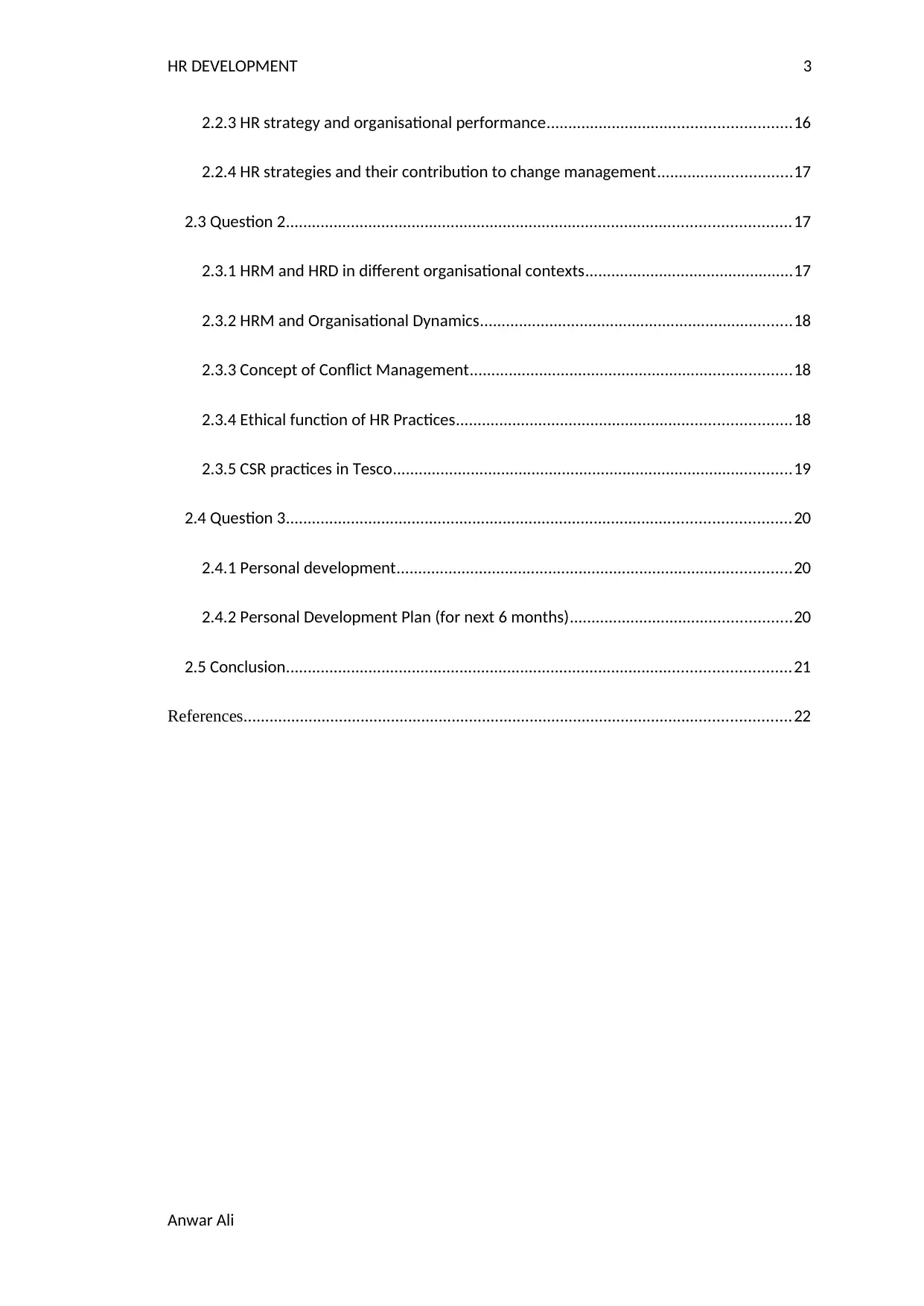
HR DEVELOPMENT 3
2.2.3 HR strategy and organisational performance........................................................16
2.2.4 HR strategies and their contribution to change management...............................17
2.3 Question 2....................................................................................................................17
2.3.1 HRM and HRD in different organisational contexts................................................17
2.3.2 HRM and Organisational Dynamics........................................................................18
2.3.3 Concept of Conflict Management..........................................................................18
2.3.4 Ethical function of HR Practices.............................................................................18
2.3.5 CSR practices in Tesco............................................................................................19
2.4 Question 3....................................................................................................................20
2.4.1 Personal development...........................................................................................20
2.4.2 Personal Development Plan (for next 6 months)...................................................20
2.5 Conclusion....................................................................................................................21
References..............................................................................................................................22
Anwar Ali
2.2.3 HR strategy and organisational performance........................................................16
2.2.4 HR strategies and their contribution to change management...............................17
2.3 Question 2....................................................................................................................17
2.3.1 HRM and HRD in different organisational contexts................................................17
2.3.2 HRM and Organisational Dynamics........................................................................18
2.3.3 Concept of Conflict Management..........................................................................18
2.3.4 Ethical function of HR Practices.............................................................................18
2.3.5 CSR practices in Tesco............................................................................................19
2.4 Question 3....................................................................................................................20
2.4.1 Personal development...........................................................................................20
2.4.2 Personal Development Plan (for next 6 months)...................................................20
2.5 Conclusion....................................................................................................................21
References..............................................................................................................................22
Anwar Ali
Paraphrase This Document
Need a fresh take? Get an instant paraphrase of this document with our AI Paraphraser
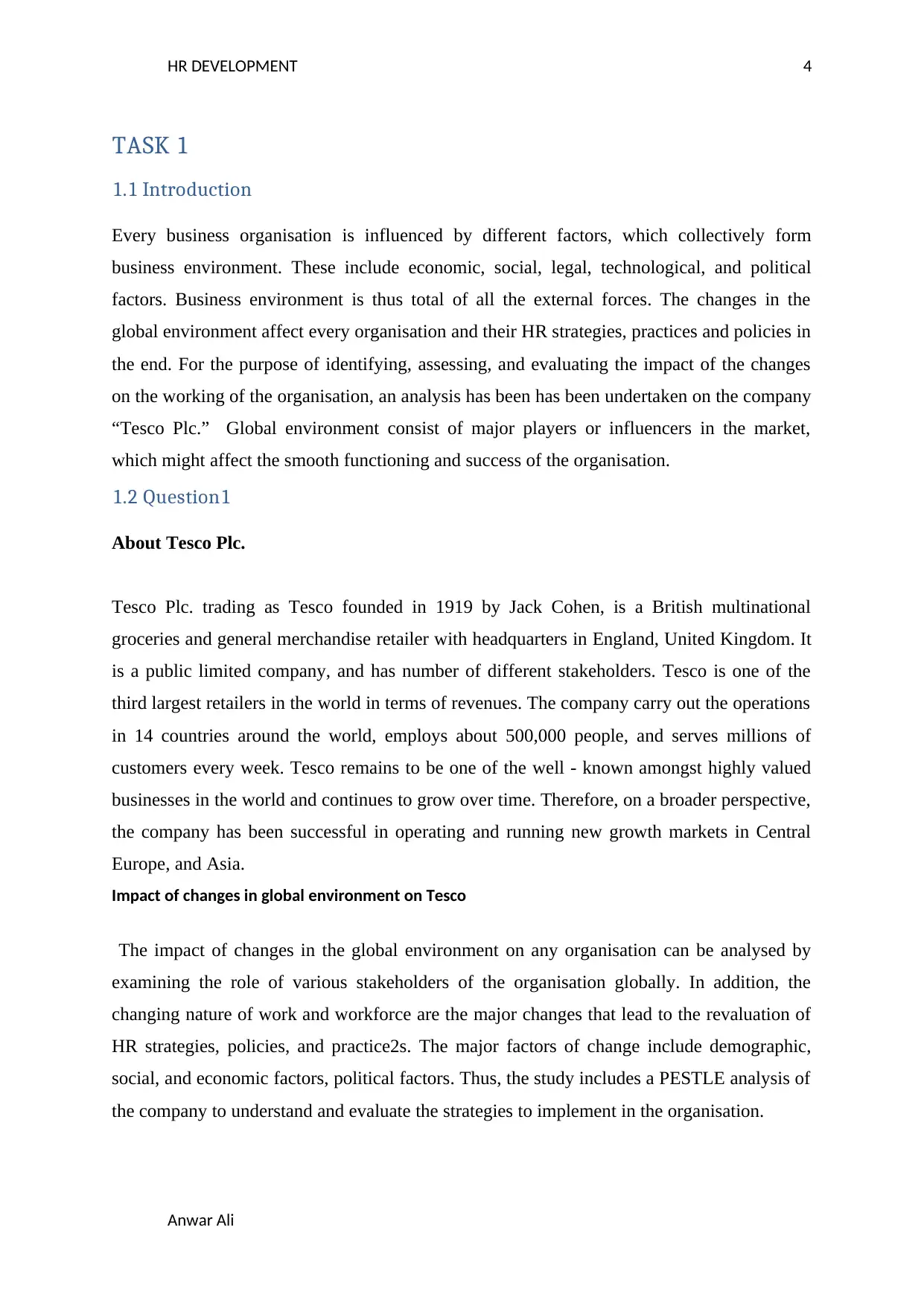
HR DEVELOPMENT 4
TASK 1
1.1 Introduction
Every business organisation is influenced by different factors, which collectively form
business environment. These include economic, social, legal, technological, and political
factors. Business environment is thus total of all the external forces. The changes in the
global environment affect every organisation and their HR strategies, practices and policies in
the end. For the purpose of identifying, assessing, and evaluating the impact of the changes
on the working of the organisation, an analysis has been has been undertaken on the company
“Tesco Plc.” Global environment consist of major players or influencers in the market,
which might affect the smooth functioning and success of the organisation.
1.2 Question1
About Tesco Plc.
Tesco Plc. trading as Tesco founded in 1919 by Jack Cohen, is a British multinational
groceries and general merchandise retailer with headquarters in England, United Kingdom. It
is a public limited company, and has number of different stakeholders. Tesco is one of the
third largest retailers in the world in terms of revenues. The company carry out the operations
in 14 countries around the world, employs about 500,000 people, and serves millions of
customers every week. Tesco remains to be one of the well - known amongst highly valued
businesses in the world and continues to grow over time. Therefore, on a broader perspective,
the company has been successful in operating and running new growth markets in Central
Europe, and Asia.
Impact of changes in global environment on Tesco
The impact of changes in the global environment on any organisation can be analysed by
examining the role of various stakeholders of the organisation globally. In addition, the
changing nature of work and workforce are the major changes that lead to the revaluation of
HR strategies, policies, and practice2s. The major factors of change include demographic,
social, and economic factors, political factors. Thus, the study includes a PESTLE analysis of
the company to understand and evaluate the strategies to implement in the organisation.
Anwar Ali
TASK 1
1.1 Introduction
Every business organisation is influenced by different factors, which collectively form
business environment. These include economic, social, legal, technological, and political
factors. Business environment is thus total of all the external forces. The changes in the
global environment affect every organisation and their HR strategies, practices and policies in
the end. For the purpose of identifying, assessing, and evaluating the impact of the changes
on the working of the organisation, an analysis has been has been undertaken on the company
“Tesco Plc.” Global environment consist of major players or influencers in the market,
which might affect the smooth functioning and success of the organisation.
1.2 Question1
About Tesco Plc.
Tesco Plc. trading as Tesco founded in 1919 by Jack Cohen, is a British multinational
groceries and general merchandise retailer with headquarters in England, United Kingdom. It
is a public limited company, and has number of different stakeholders. Tesco is one of the
third largest retailers in the world in terms of revenues. The company carry out the operations
in 14 countries around the world, employs about 500,000 people, and serves millions of
customers every week. Tesco remains to be one of the well - known amongst highly valued
businesses in the world and continues to grow over time. Therefore, on a broader perspective,
the company has been successful in operating and running new growth markets in Central
Europe, and Asia.
Impact of changes in global environment on Tesco
The impact of changes in the global environment on any organisation can be analysed by
examining the role of various stakeholders of the organisation globally. In addition, the
changing nature of work and workforce are the major changes that lead to the revaluation of
HR strategies, policies, and practice2s. The major factors of change include demographic,
social, and economic factors, political factors. Thus, the study includes a PESTLE analysis of
the company to understand and evaluate the strategies to implement in the organisation.
Anwar Ali
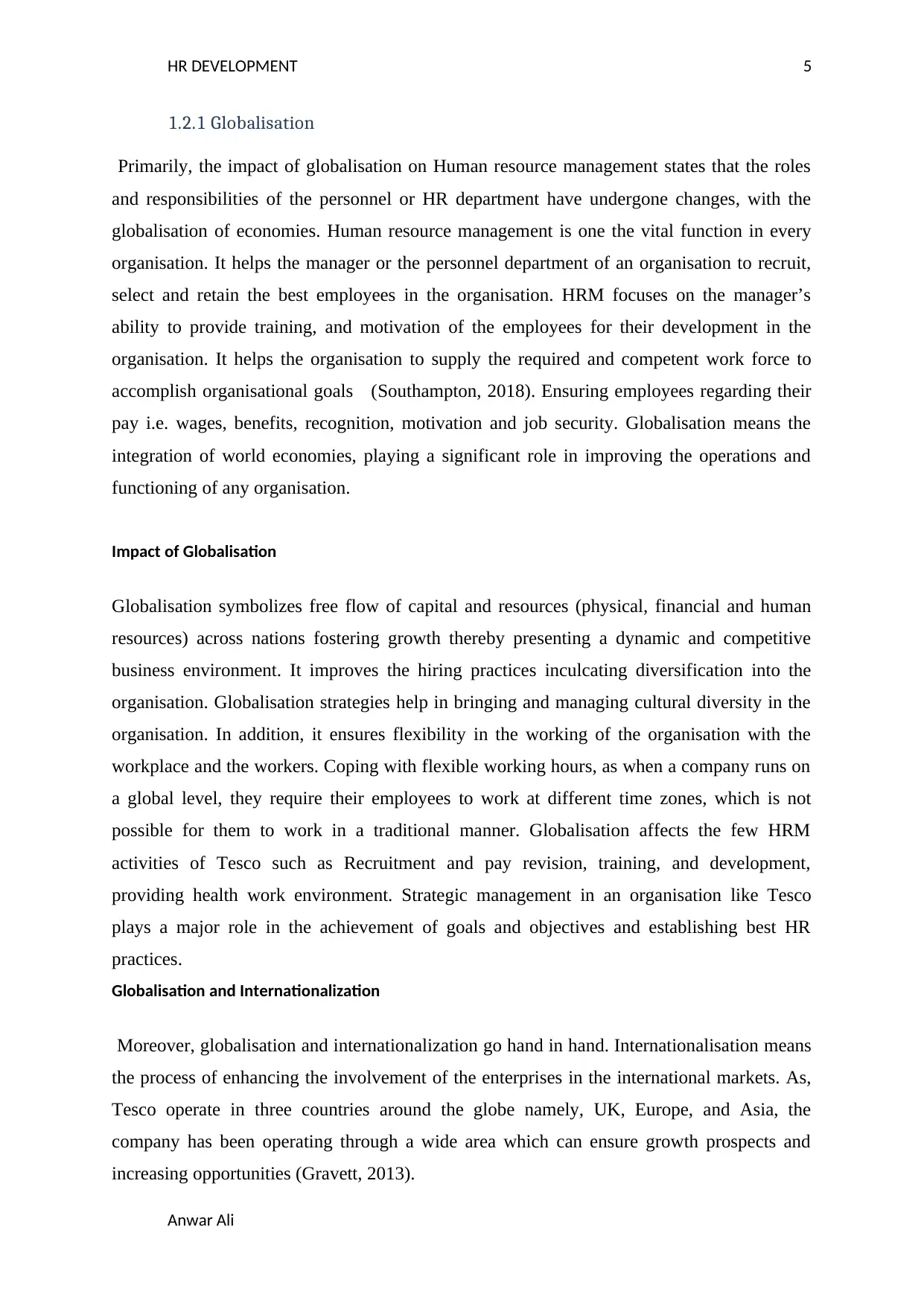
HR DEVELOPMENT 5
1.2.1 Globalisation
Primarily, the impact of globalisation on Human resource management states that the roles
and responsibilities of the personnel or HR department have undergone changes, with the
globalisation of economies. Human resource management is one the vital function in every
organisation. It helps the manager or the personnel department of an organisation to recruit,
select and retain the best employees in the organisation. HRM focuses on the manager’s
ability to provide training, and motivation of the employees for their development in the
organisation. It helps the organisation to supply the required and competent work force to
accomplish organisational goals (Southampton, 2018). Ensuring employees regarding their
pay i.e. wages, benefits, recognition, motivation and job security. Globalisation means the
integration of world economies, playing a significant role in improving the operations and
functioning of any organisation.
Impact of Globalisation
Globalisation symbolizes free flow of capital and resources (physical, financial and human
resources) across nations fostering growth thereby presenting a dynamic and competitive
business environment. It improves the hiring practices inculcating diversification into the
organisation. Globalisation strategies help in bringing and managing cultural diversity in the
organisation. In addition, it ensures flexibility in the working of the organisation with the
workplace and the workers. Coping with flexible working hours, as when a company runs on
a global level, they require their employees to work at different time zones, which is not
possible for them to work in a traditional manner. Globalisation affects the few HRM
activities of Tesco such as Recruitment and pay revision, training, and development,
providing health work environment. Strategic management in an organisation like Tesco
plays a major role in the achievement of goals and objectives and establishing best HR
practices.
Globalisation and Internationalization
Moreover, globalisation and internationalization go hand in hand. Internationalisation means
the process of enhancing the involvement of the enterprises in the international markets. As,
Tesco operate in three countries around the globe namely, UK, Europe, and Asia, the
company has been operating through a wide area which can ensure growth prospects and
increasing opportunities (Gravett, 2013).
Anwar Ali
1.2.1 Globalisation
Primarily, the impact of globalisation on Human resource management states that the roles
and responsibilities of the personnel or HR department have undergone changes, with the
globalisation of economies. Human resource management is one the vital function in every
organisation. It helps the manager or the personnel department of an organisation to recruit,
select and retain the best employees in the organisation. HRM focuses on the manager’s
ability to provide training, and motivation of the employees for their development in the
organisation. It helps the organisation to supply the required and competent work force to
accomplish organisational goals (Southampton, 2018). Ensuring employees regarding their
pay i.e. wages, benefits, recognition, motivation and job security. Globalisation means the
integration of world economies, playing a significant role in improving the operations and
functioning of any organisation.
Impact of Globalisation
Globalisation symbolizes free flow of capital and resources (physical, financial and human
resources) across nations fostering growth thereby presenting a dynamic and competitive
business environment. It improves the hiring practices inculcating diversification into the
organisation. Globalisation strategies help in bringing and managing cultural diversity in the
organisation. In addition, it ensures flexibility in the working of the organisation with the
workplace and the workers. Coping with flexible working hours, as when a company runs on
a global level, they require their employees to work at different time zones, which is not
possible for them to work in a traditional manner. Globalisation affects the few HRM
activities of Tesco such as Recruitment and pay revision, training, and development,
providing health work environment. Strategic management in an organisation like Tesco
plays a major role in the achievement of goals and objectives and establishing best HR
practices.
Globalisation and Internationalization
Moreover, globalisation and internationalization go hand in hand. Internationalisation means
the process of enhancing the involvement of the enterprises in the international markets. As,
Tesco operate in three countries around the globe namely, UK, Europe, and Asia, the
company has been operating through a wide area which can ensure growth prospects and
increasing opportunities (Gravett, 2013).
Anwar Ali
⊘ This is a preview!⊘
Do you want full access?
Subscribe today to unlock all pages.

Trusted by 1+ million students worldwide
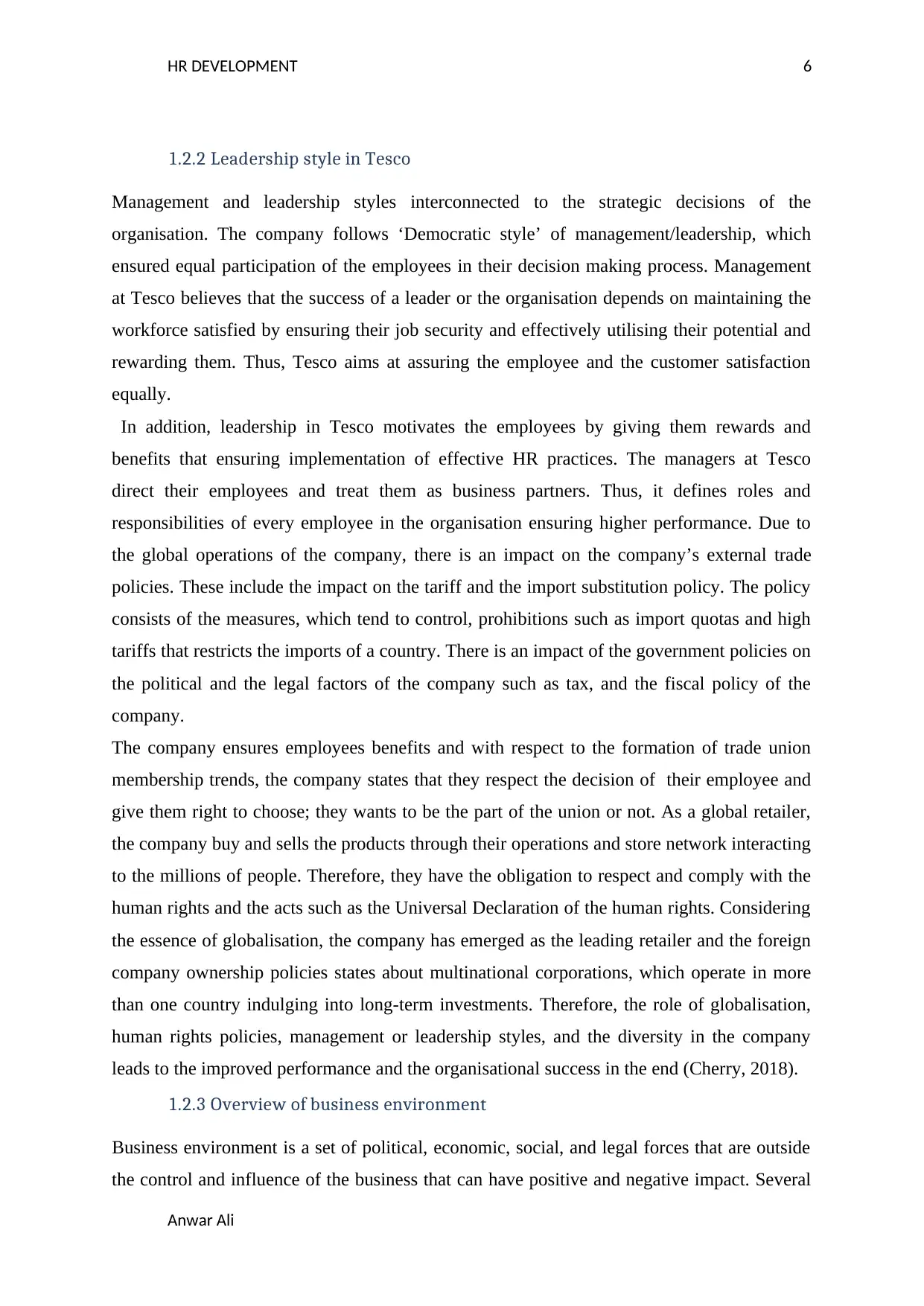
HR DEVELOPMENT 6
1.2.2 Leadership style in Tesco
Management and leadership styles interconnected to the strategic decisions of the
organisation. The company follows ‘Democratic style’ of management/leadership, which
ensured equal participation of the employees in their decision making process. Management
at Tesco believes that the success of a leader or the organisation depends on maintaining the
workforce satisfied by ensuring their job security and effectively utilising their potential and
rewarding them. Thus, Tesco aims at assuring the employee and the customer satisfaction
equally.
In addition, leadership in Tesco motivates the employees by giving them rewards and
benefits that ensuring implementation of effective HR practices. The managers at Tesco
direct their employees and treat them as business partners. Thus, it defines roles and
responsibilities of every employee in the organisation ensuring higher performance. Due to
the global operations of the company, there is an impact on the company’s external trade
policies. These include the impact on the tariff and the import substitution policy. The policy
consists of the measures, which tend to control, prohibitions such as import quotas and high
tariffs that restricts the imports of a country. There is an impact of the government policies on
the political and the legal factors of the company such as tax, and the fiscal policy of the
company.
The company ensures employees benefits and with respect to the formation of trade union
membership trends, the company states that they respect the decision of their employee and
give them right to choose; they wants to be the part of the union or not. As a global retailer,
the company buy and sells the products through their operations and store network interacting
to the millions of people. Therefore, they have the obligation to respect and comply with the
human rights and the acts such as the Universal Declaration of the human rights. Considering
the essence of globalisation, the company has emerged as the leading retailer and the foreign
company ownership policies states about multinational corporations, which operate in more
than one country indulging into long-term investments. Therefore, the role of globalisation,
human rights policies, management or leadership styles, and the diversity in the company
leads to the improved performance and the organisational success in the end (Cherry, 2018).
1.2.3 Overview of business environment
Business environment is a set of political, economic, social, and legal forces that are outside
the control and influence of the business that can have positive and negative impact. Several
Anwar Ali
1.2.2 Leadership style in Tesco
Management and leadership styles interconnected to the strategic decisions of the
organisation. The company follows ‘Democratic style’ of management/leadership, which
ensured equal participation of the employees in their decision making process. Management
at Tesco believes that the success of a leader or the organisation depends on maintaining the
workforce satisfied by ensuring their job security and effectively utilising their potential and
rewarding them. Thus, Tesco aims at assuring the employee and the customer satisfaction
equally.
In addition, leadership in Tesco motivates the employees by giving them rewards and
benefits that ensuring implementation of effective HR practices. The managers at Tesco
direct their employees and treat them as business partners. Thus, it defines roles and
responsibilities of every employee in the organisation ensuring higher performance. Due to
the global operations of the company, there is an impact on the company’s external trade
policies. These include the impact on the tariff and the import substitution policy. The policy
consists of the measures, which tend to control, prohibitions such as import quotas and high
tariffs that restricts the imports of a country. There is an impact of the government policies on
the political and the legal factors of the company such as tax, and the fiscal policy of the
company.
The company ensures employees benefits and with respect to the formation of trade union
membership trends, the company states that they respect the decision of their employee and
give them right to choose; they wants to be the part of the union or not. As a global retailer,
the company buy and sells the products through their operations and store network interacting
to the millions of people. Therefore, they have the obligation to respect and comply with the
human rights and the acts such as the Universal Declaration of the human rights. Considering
the essence of globalisation, the company has emerged as the leading retailer and the foreign
company ownership policies states about multinational corporations, which operate in more
than one country indulging into long-term investments. Therefore, the role of globalisation,
human rights policies, management or leadership styles, and the diversity in the company
leads to the improved performance and the organisational success in the end (Cherry, 2018).
1.2.3 Overview of business environment
Business environment is a set of political, economic, social, and legal forces that are outside
the control and influence of the business that can have positive and negative impact. Several
Anwar Ali
Paraphrase This Document
Need a fresh take? Get an instant paraphrase of this document with our AI Paraphraser
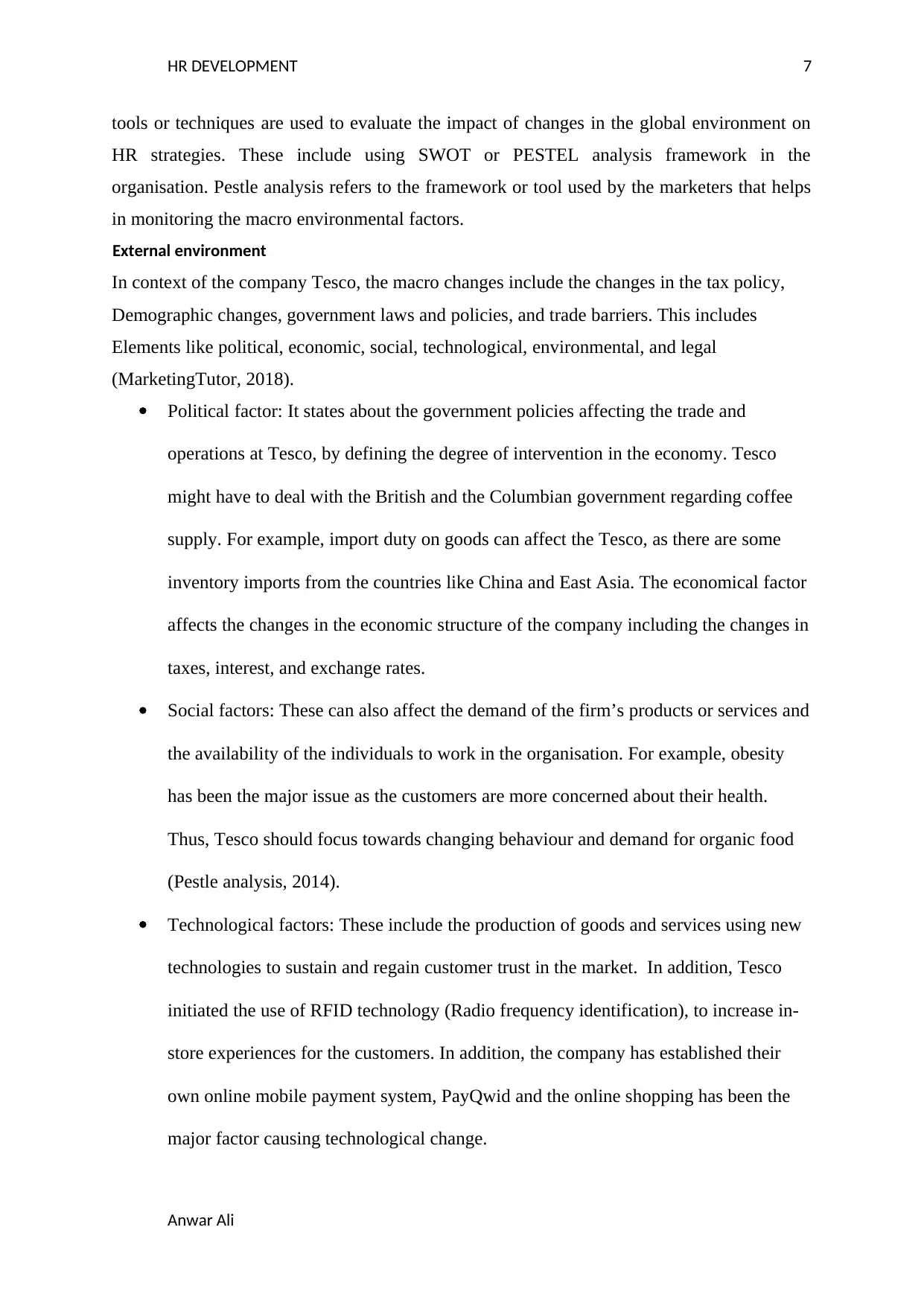
HR DEVELOPMENT 7
tools or techniques are used to evaluate the impact of changes in the global environment on
HR strategies. These include using SWOT or PESTEL analysis framework in the
organisation. Pestle analysis refers to the framework or tool used by the marketers that helps
in monitoring the macro environmental factors.
External environment
In context of the company Tesco, the macro changes include the changes in the tax policy,
Demographic changes, government laws and policies, and trade barriers. This includes
Elements like political, economic, social, technological, environmental, and legal
(MarketingTutor, 2018).
Political factor: It states about the government policies affecting the trade and
operations at Tesco, by defining the degree of intervention in the economy. Tesco
might have to deal with the British and the Columbian government regarding coffee
supply. For example, import duty on goods can affect the Tesco, as there are some
inventory imports from the countries like China and East Asia. The economical factor
affects the changes in the economic structure of the company including the changes in
taxes, interest, and exchange rates.
Social factors: These can also affect the demand of the firm’s products or services and
the availability of the individuals to work in the organisation. For example, obesity
has been the major issue as the customers are more concerned about their health.
Thus, Tesco should focus towards changing behaviour and demand for organic food
(Pestle analysis, 2014).
Technological factors: These include the production of goods and services using new
technologies to sustain and regain customer trust in the market. In addition, Tesco
initiated the use of RFID technology (Radio frequency identification), to increase in-
store experiences for the customers. In addition, the company has established their
own online mobile payment system, PayQwid and the online shopping has been the
major factor causing technological change.
Anwar Ali
tools or techniques are used to evaluate the impact of changes in the global environment on
HR strategies. These include using SWOT or PESTEL analysis framework in the
organisation. Pestle analysis refers to the framework or tool used by the marketers that helps
in monitoring the macro environmental factors.
External environment
In context of the company Tesco, the macro changes include the changes in the tax policy,
Demographic changes, government laws and policies, and trade barriers. This includes
Elements like political, economic, social, technological, environmental, and legal
(MarketingTutor, 2018).
Political factor: It states about the government policies affecting the trade and
operations at Tesco, by defining the degree of intervention in the economy. Tesco
might have to deal with the British and the Columbian government regarding coffee
supply. For example, import duty on goods can affect the Tesco, as there are some
inventory imports from the countries like China and East Asia. The economical factor
affects the changes in the economic structure of the company including the changes in
taxes, interest, and exchange rates.
Social factors: These can also affect the demand of the firm’s products or services and
the availability of the individuals to work in the organisation. For example, obesity
has been the major issue as the customers are more concerned about their health.
Thus, Tesco should focus towards changing behaviour and demand for organic food
(Pestle analysis, 2014).
Technological factors: These include the production of goods and services using new
technologies to sustain and regain customer trust in the market. In addition, Tesco
initiated the use of RFID technology (Radio frequency identification), to increase in-
store experiences for the customers. In addition, the company has established their
own online mobile payment system, PayQwid and the online shopping has been the
major factor causing technological change.
Anwar Ali
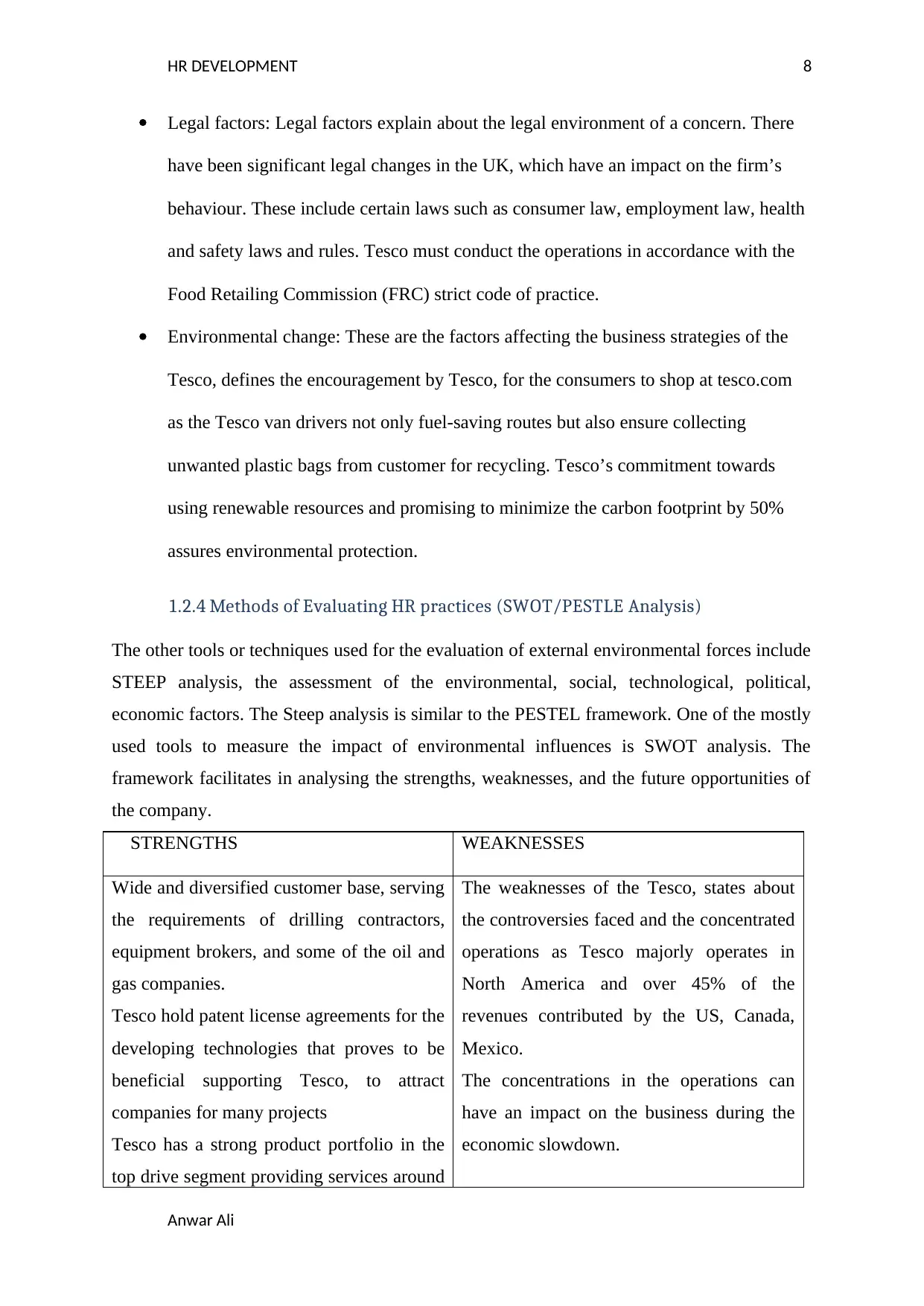
HR DEVELOPMENT 8
Legal factors: Legal factors explain about the legal environment of a concern. There
have been significant legal changes in the UK, which have an impact on the firm’s
behaviour. These include certain laws such as consumer law, employment law, health
and safety laws and rules. Tesco must conduct the operations in accordance with the
Food Retailing Commission (FRC) strict code of practice.
Environmental change: These are the factors affecting the business strategies of the
Tesco, defines the encouragement by Tesco, for the consumers to shop at tesco.com
as the Tesco van drivers not only fuel-saving routes but also ensure collecting
unwanted plastic bags from customer for recycling. Tesco’s commitment towards
using renewable resources and promising to minimize the carbon footprint by 50%
assures environmental protection.
1.2.4 Methods of Evaluating HR practices (SWOT/PESTLE Analysis)
The other tools or techniques used for the evaluation of external environmental forces include
STEEP analysis, the assessment of the environmental, social, technological, political,
economic factors. The Steep analysis is similar to the PESTEL framework. One of the mostly
used tools to measure the impact of environmental influences is SWOT analysis. The
framework facilitates in analysing the strengths, weaknesses, and the future opportunities of
the company.
STRENGTHS WEAKNESSES
Wide and diversified customer base, serving
the requirements of drilling contractors,
equipment brokers, and some of the oil and
gas companies.
Tesco hold patent license agreements for the
developing technologies that proves to be
beneficial supporting Tesco, to attract
companies for many projects
Tesco has a strong product portfolio in the
top drive segment providing services around
The weaknesses of the Tesco, states about
the controversies faced and the concentrated
operations as Tesco majorly operates in
North America and over 45% of the
revenues contributed by the US, Canada,
Mexico.
The concentrations in the operations can
have an impact on the business during the
economic slowdown.
Anwar Ali
Legal factors: Legal factors explain about the legal environment of a concern. There
have been significant legal changes in the UK, which have an impact on the firm’s
behaviour. These include certain laws such as consumer law, employment law, health
and safety laws and rules. Tesco must conduct the operations in accordance with the
Food Retailing Commission (FRC) strict code of practice.
Environmental change: These are the factors affecting the business strategies of the
Tesco, defines the encouragement by Tesco, for the consumers to shop at tesco.com
as the Tesco van drivers not only fuel-saving routes but also ensure collecting
unwanted plastic bags from customer for recycling. Tesco’s commitment towards
using renewable resources and promising to minimize the carbon footprint by 50%
assures environmental protection.
1.2.4 Methods of Evaluating HR practices (SWOT/PESTLE Analysis)
The other tools or techniques used for the evaluation of external environmental forces include
STEEP analysis, the assessment of the environmental, social, technological, political,
economic factors. The Steep analysis is similar to the PESTEL framework. One of the mostly
used tools to measure the impact of environmental influences is SWOT analysis. The
framework facilitates in analysing the strengths, weaknesses, and the future opportunities of
the company.
STRENGTHS WEAKNESSES
Wide and diversified customer base, serving
the requirements of drilling contractors,
equipment brokers, and some of the oil and
gas companies.
Tesco hold patent license agreements for the
developing technologies that proves to be
beneficial supporting Tesco, to attract
companies for many projects
Tesco has a strong product portfolio in the
top drive segment providing services around
The weaknesses of the Tesco, states about
the controversies faced and the concentrated
operations as Tesco majorly operates in
North America and over 45% of the
revenues contributed by the US, Canada,
Mexico.
The concentrations in the operations can
have an impact on the business during the
economic slowdown.
Anwar Ali
⊘ This is a preview!⊘
Do you want full access?
Subscribe today to unlock all pages.

Trusted by 1+ million students worldwide
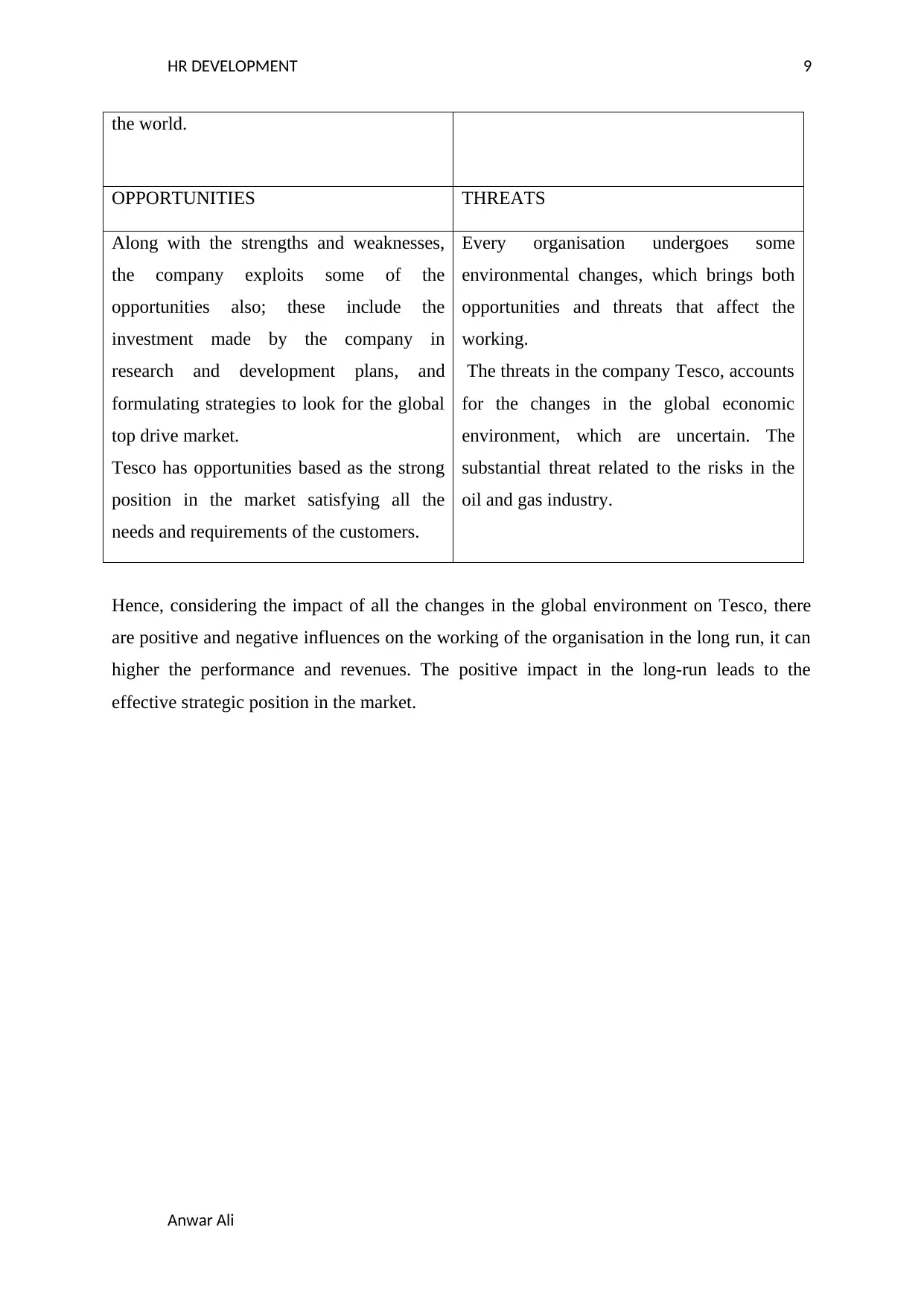
HR DEVELOPMENT 9
the world.
OPPORTUNITIES THREATS
Along with the strengths and weaknesses,
the company exploits some of the
opportunities also; these include the
investment made by the company in
research and development plans, and
formulating strategies to look for the global
top drive market.
Tesco has opportunities based as the strong
position in the market satisfying all the
needs and requirements of the customers.
Every organisation undergoes some
environmental changes, which brings both
opportunities and threats that affect the
working.
The threats in the company Tesco, accounts
for the changes in the global economic
environment, which are uncertain. The
substantial threat related to the risks in the
oil and gas industry.
Hence, considering the impact of all the changes in the global environment on Tesco, there
are positive and negative influences on the working of the organisation in the long run, it can
higher the performance and revenues. The positive impact in the long-run leads to the
effective strategic position in the market.
Anwar Ali
the world.
OPPORTUNITIES THREATS
Along with the strengths and weaknesses,
the company exploits some of the
opportunities also; these include the
investment made by the company in
research and development plans, and
formulating strategies to look for the global
top drive market.
Tesco has opportunities based as the strong
position in the market satisfying all the
needs and requirements of the customers.
Every organisation undergoes some
environmental changes, which brings both
opportunities and threats that affect the
working.
The threats in the company Tesco, accounts
for the changes in the global economic
environment, which are uncertain. The
substantial threat related to the risks in the
oil and gas industry.
Hence, considering the impact of all the changes in the global environment on Tesco, there
are positive and negative influences on the working of the organisation in the long run, it can
higher the performance and revenues. The positive impact in the long-run leads to the
effective strategic position in the market.
Anwar Ali
Paraphrase This Document
Need a fresh take? Get an instant paraphrase of this document with our AI Paraphraser
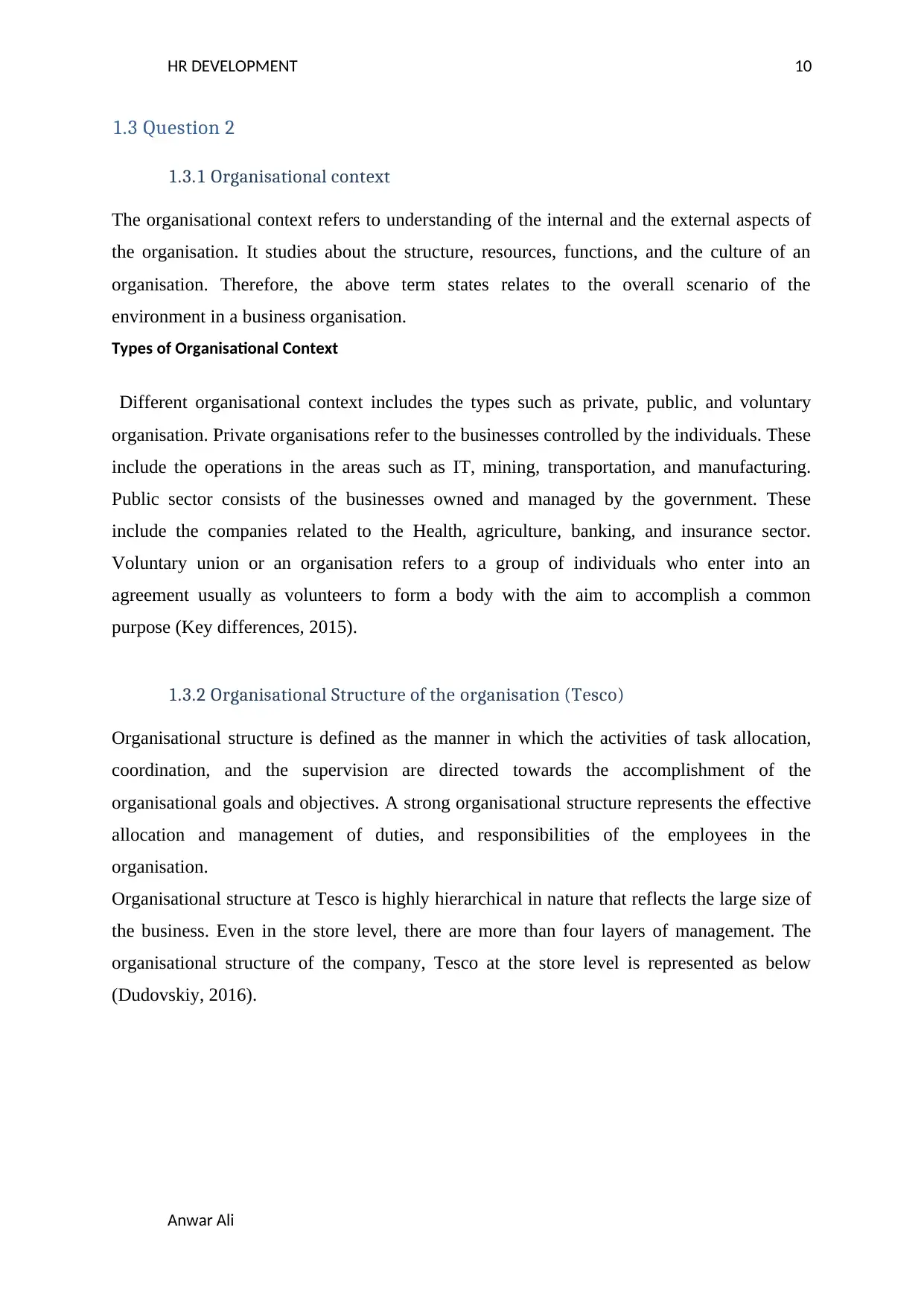
HR DEVELOPMENT 10
1.3 Question 2
1.3.1 Organisational context
The organisational context refers to understanding of the internal and the external aspects of
the organisation. It studies about the structure, resources, functions, and the culture of an
organisation. Therefore, the above term states relates to the overall scenario of the
environment in a business organisation.
Types of Organisational Context
Different organisational context includes the types such as private, public, and voluntary
organisation. Private organisations refer to the businesses controlled by the individuals. These
include the operations in the areas such as IT, mining, transportation, and manufacturing.
Public sector consists of the businesses owned and managed by the government. These
include the companies related to the Health, agriculture, banking, and insurance sector.
Voluntary union or an organisation refers to a group of individuals who enter into an
agreement usually as volunteers to form a body with the aim to accomplish a common
purpose (Key differences, 2015).
1.3.2 Organisational Structure of the organisation (Tesco)
Organisational structure is defined as the manner in which the activities of task allocation,
coordination, and the supervision are directed towards the accomplishment of the
organisational goals and objectives. A strong organisational structure represents the effective
allocation and management of duties, and responsibilities of the employees in the
organisation.
Organisational structure at Tesco is highly hierarchical in nature that reflects the large size of
the business. Even in the store level, there are more than four layers of management. The
organisational structure of the company, Tesco at the store level is represented as below
(Dudovskiy, 2016).
Anwar Ali
1.3 Question 2
1.3.1 Organisational context
The organisational context refers to understanding of the internal and the external aspects of
the organisation. It studies about the structure, resources, functions, and the culture of an
organisation. Therefore, the above term states relates to the overall scenario of the
environment in a business organisation.
Types of Organisational Context
Different organisational context includes the types such as private, public, and voluntary
organisation. Private organisations refer to the businesses controlled by the individuals. These
include the operations in the areas such as IT, mining, transportation, and manufacturing.
Public sector consists of the businesses owned and managed by the government. These
include the companies related to the Health, agriculture, banking, and insurance sector.
Voluntary union or an organisation refers to a group of individuals who enter into an
agreement usually as volunteers to form a body with the aim to accomplish a common
purpose (Key differences, 2015).
1.3.2 Organisational Structure of the organisation (Tesco)
Organisational structure is defined as the manner in which the activities of task allocation,
coordination, and the supervision are directed towards the accomplishment of the
organisational goals and objectives. A strong organisational structure represents the effective
allocation and management of duties, and responsibilities of the employees in the
organisation.
Organisational structure at Tesco is highly hierarchical in nature that reflects the large size of
the business. Even in the store level, there are more than four layers of management. The
organisational structure of the company, Tesco at the store level is represented as below
(Dudovskiy, 2016).
Anwar Ali
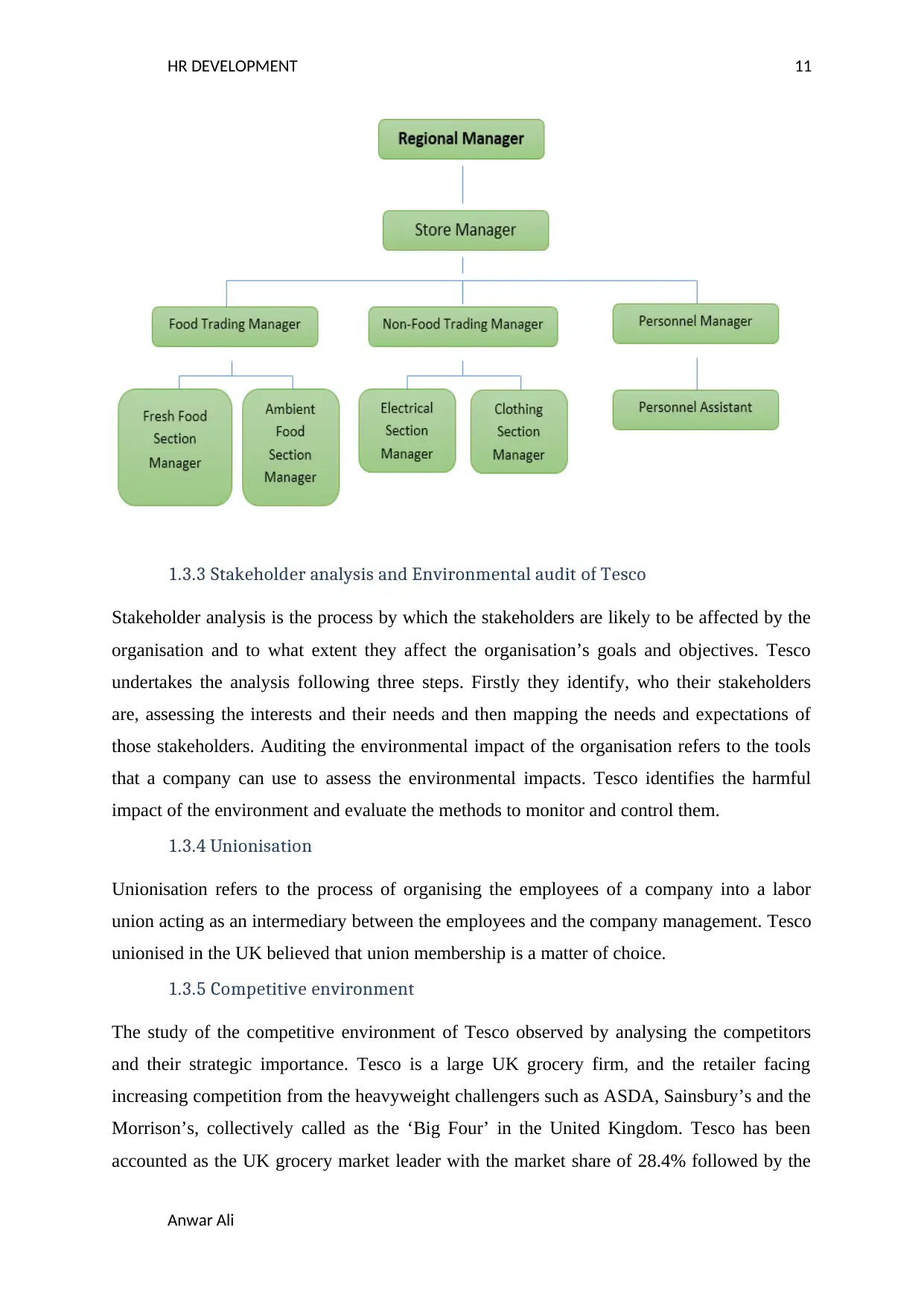
HR DEVELOPMENT 11
1.3.3 Stakeholder analysis and Environmental audit of Tesco
Stakeholder analysis is the process by which the stakeholders are likely to be affected by the
organisation and to what extent they affect the organisation’s goals and objectives. Tesco
undertakes the analysis following three steps. Firstly they identify, who their stakeholders
are, assessing the interests and their needs and then mapping the needs and expectations of
those stakeholders. Auditing the environmental impact of the organisation refers to the tools
that a company can use to assess the environmental impacts. Tesco identifies the harmful
impact of the environment and evaluate the methods to monitor and control them.
1.3.4 Unionisation
Unionisation refers to the process of organising the employees of a company into a labor
union acting as an intermediary between the employees and the company management. Tesco
unionised in the UK believed that union membership is a matter of choice.
1.3.5 Competitive environment
The study of the competitive environment of Tesco observed by analysing the competitors
and their strategic importance. Tesco is a large UK grocery firm, and the retailer facing
increasing competition from the heavyweight challengers such as ASDA, Sainsbury’s and the
Morrison’s, collectively called as the ‘Big Four’ in the United Kingdom. Tesco has been
accounted as the UK grocery market leader with the market share of 28.4% followed by the
Anwar Ali
1.3.3 Stakeholder analysis and Environmental audit of Tesco
Stakeholder analysis is the process by which the stakeholders are likely to be affected by the
organisation and to what extent they affect the organisation’s goals and objectives. Tesco
undertakes the analysis following three steps. Firstly they identify, who their stakeholders
are, assessing the interests and their needs and then mapping the needs and expectations of
those stakeholders. Auditing the environmental impact of the organisation refers to the tools
that a company can use to assess the environmental impacts. Tesco identifies the harmful
impact of the environment and evaluate the methods to monitor and control them.
1.3.4 Unionisation
Unionisation refers to the process of organising the employees of a company into a labor
union acting as an intermediary between the employees and the company management. Tesco
unionised in the UK believed that union membership is a matter of choice.
1.3.5 Competitive environment
The study of the competitive environment of Tesco observed by analysing the competitors
and their strategic importance. Tesco is a large UK grocery firm, and the retailer facing
increasing competition from the heavyweight challengers such as ASDA, Sainsbury’s and the
Morrison’s, collectively called as the ‘Big Four’ in the United Kingdom. Tesco has been
accounted as the UK grocery market leader with the market share of 28.4% followed by the
Anwar Ali
⊘ This is a preview!⊘
Do you want full access?
Subscribe today to unlock all pages.

Trusted by 1+ million students worldwide
1 out of 24
Related Documents
Your All-in-One AI-Powered Toolkit for Academic Success.
+13062052269
info@desklib.com
Available 24*7 on WhatsApp / Email
![[object Object]](/_next/static/media/star-bottom.7253800d.svg)
Unlock your academic potential
Copyright © 2020–2025 A2Z Services. All Rights Reserved. Developed and managed by ZUCOL.





